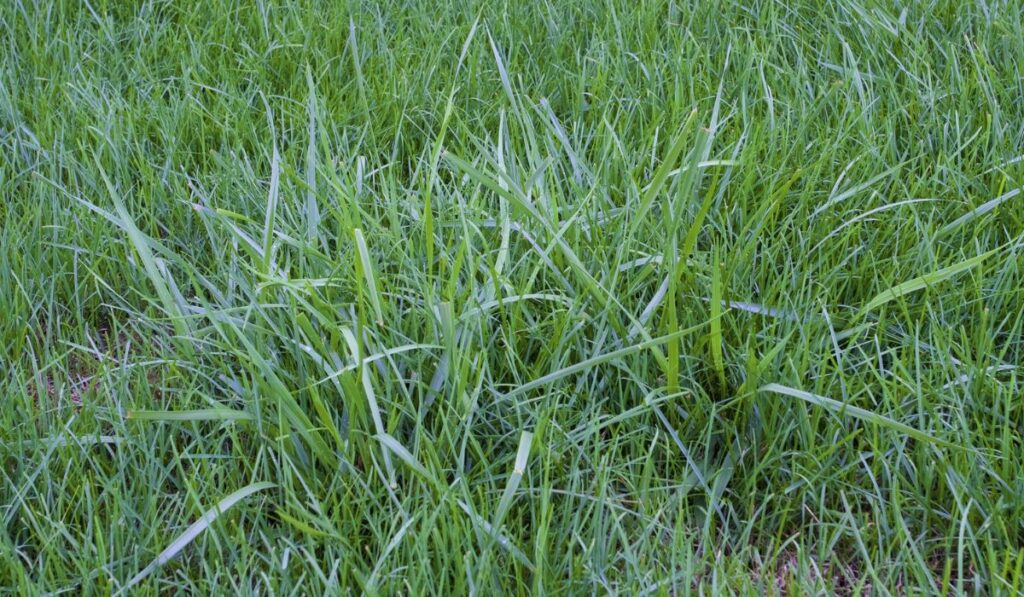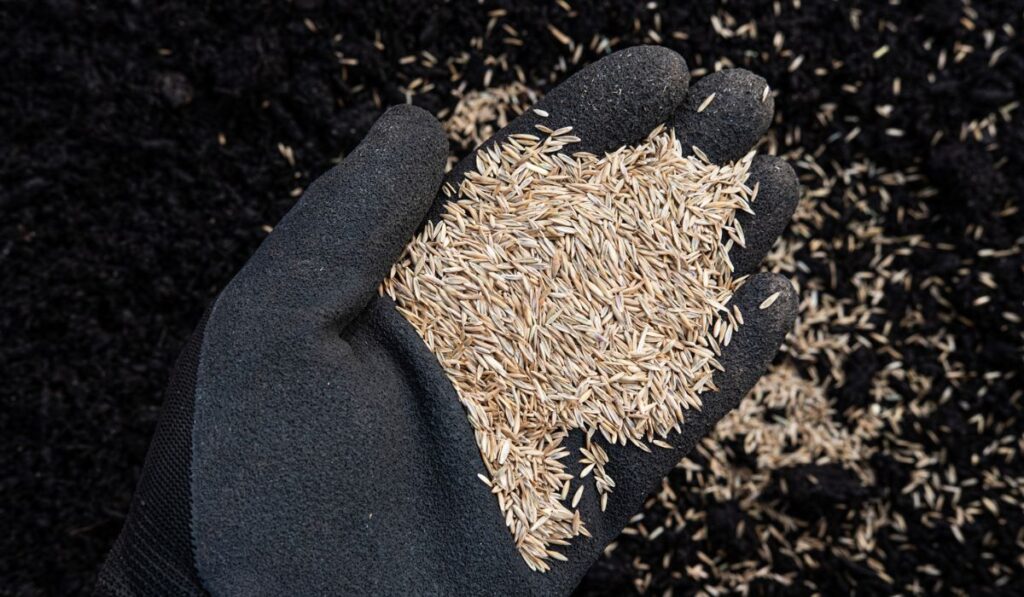Originating from Europe, tall fescue grass is now found in North Africa, Europe, and North America. Many homeowners prefer this grass due to its deep green color that stays the same all winter, its disease resistance, and its density. This perennial bunchgrass establishes quickly, requires very little maintenance, and can be grown as an easy turf grass alternative.
Fall is the best time of the year to grow tall fescue grass. It grows best from seeds, which should be planted when the soil temperature is between 60 to 65 degrees Fahrenheit. This grass has a deep root system that allows it to survive well, even in areas where water is scarce.
Tall fescue grass offers lawn owners excellent options for improving lawn durability and resilience. Let’s look at the main characteristics of tall fescue grass and what’s the best time to plant it. We’ll also learn about its watering needs and whether it’s possible to plant this grass in summer.
What is Tall Fescue?

Tall fescue grass is a cool-weather perennial turf grass with low fertilization and mowing needs. It adapts well even to clay soil and maintains a dark green color even in winter.
Its ribbed blades are wide and coarse to the touch. As new blades grow, they emerge in a rolled-up form. This grass is unique because of its upright, fast, clumping growth habit, also called bunchgrass.
Tall fescue grass doesn’t spread by horizontal below and above-ground stems; instead, it spreads through vertical shoots known as tillers, which grow from the plant’s base.
This growth habit makes it easier for gardeners to contain this grass and keep it out of flower beds; however, in case of damage, the capacity of tall fescue to repair itself is minimal.
Tall fescue is a hardy and tough grass, which makes it an ideal choice for play areas, although you might need to reseed in case bare spots occur. With an almost 3-foot deep root system, this grass offers exceptional drought and heat tolerance.
Is Tall Fescue Warm Season or Cool Season Grass?
Tall fescue is a cool season grass with leaves that turn green in mid-spring and maintain their color into late fall. It has the highest traffic, cold, heat, drought, and shade tolerance and is preferred by gardeners looking for a low-maintenance lawn.
This grass can thrive in places with partial shade and full sun. It even grows well in areas where it’s too cold for warm-season grasses and too hot for cool grasses.
What Time of Year is Best for Planting Tall Fescue?
Timing tall fescue seeding to correspond with its natural growth cycle helps to optimize its life cycle. The best time to plant tall fescue is during spring, when the cool weather facilitates vigorous growth. The second best option for planting tall fescue seeds is early spring.
A soil temperature of around 60 to 65 degrees Fahrenheit is ideal for tall fescue germination. Planting your seeds in the fall also makes it possible to take advantage of fall rains.
As a result, tall fescue will require less supplemental watering, and you’ll be able to save time and energy.
Can You Plant Tall Fescue in the Summer?
Although the best time to plant tall fescue grass is fall and spring, you can install tall fescue sod in the summer by taking adequate steps to ensure the grass survives heat and disease stress.
The most crucial step is to buy high-quality, healthy sod. Make sure it’s delivered to your home or workplace as soon as it’s cut. Install it immediately, and don’t let it dry out. Water it as soon as it’s laid.
Remember that summer heat can dry out sod quickly and cause it to wilt. Therefore, water is essential for any sod installation, especially in the summer when strong sunshine and high temperatures can quickly suck out the moisture from the grass and soil.
Warm temperatures can also stress the grass, making it prone to disease, but with proper fungicide applications, they can combat these diseases.
How Often Does Tall Fescue Grass Need to Be Watered?

Tall fescue grass needs 1 to 1¾ inches of water per week. When watering, ensure the soil is wet to a depth of 4 to 6 inches. The long roots of tall fescue make it drought-resistant. Therefore, there’s no need to water this grass in case of adequate rainfall.
Watering Tall Fescue Sod
In the case of tall fescue sod, getting the correct amount of irrigation in the initial six weeks is essential as it helps get the sod rooted down and established.
Most irrigation systems run on timers, and it’s impossible to set them up to supply a particular amount of water. Depending on water pressure and flow, it’s difficult to determine how long you should run your irrigation system to achieve the 1-inch mark.
Instead, you can make sure your sod is getting sufficient water with the help of the following strategies:
Touch the Soil
The ground should be moist and soft and not muddy. To test this, insert your finger through the sod almost 1½ inches into the soil. If the soil feels moist, it’s good, but if it’s dry, your tall fescue sod isn’t receiving enough water. A muddy soil is a sign of too much water.
Measure the Water
You can also find out how much water is provided to your lawn by your irrigation system with the help of a bowl test. Put a few empty bowls around your lawn and allow your irrigation system to run its full cycle.
When the cycle is complete, use a rain gauge or ruler to measure the water collected in the bowls. This will tell you the amount of water put out by your irrigation system so you can decide how often or how long you should run your irrigation system to achieve the 1-inch of water recommendation.
You’ll notice that some bowls have more water than others. This is because irrigation systems are typically inconsistent in their spray patterns.
Make a note of the areas where the water level is less even and consider spot-watering those areas on the hottest days using a hose.
How to Utilize Your Irrigation System
The object of any irrigation system is to ensure the water goes down into the soil column below the lawn after passing through the roots. The roots follow the water, and deeper roots are a foundation of a healthier lawn.
The best practice is that instead of running the irrigation cycle for half an hour, run it two times for 15 minutes. This ensures the water reaches into the soil instead of just running on top of it.
When the sod grows in summer, it’s not just growing roots into your lawn’s soil but also growing leaf blades vertically. Around the 4-week mark, you’ll need to mow your lawn.
Mowing Your Lawn
Turn off your irrigation system a day before the first mowing to ensure the soil isn’t too soft. Your mower wheels can become stuck in the soil or create ruts if the soil is too soft. Turn your irrigation system back on after mowing to resume your irrigation program.
